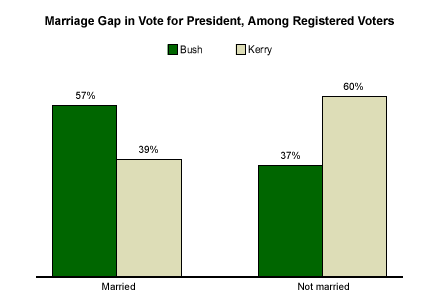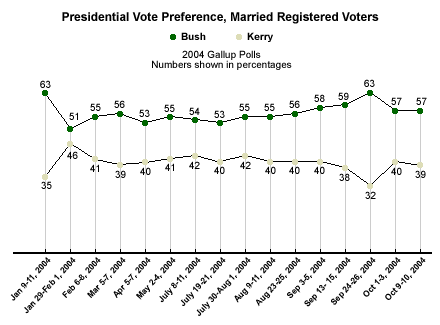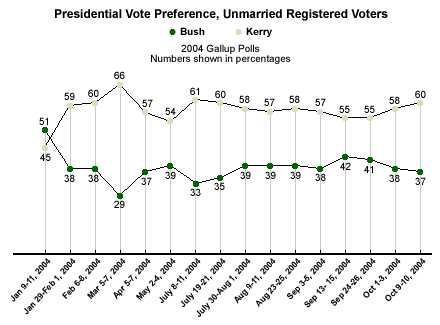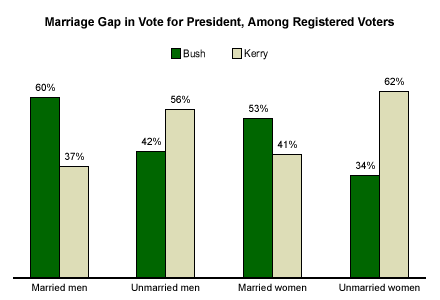Democratic candidate John Kerry's performance in the first presidential debate quickly and dramatically changed the nature of the presidential campaign. But some things stayed the same. The wide gulf in voting preferences between married and unmarried Americans persists. In fact, the "marriage gap" has not only been evident, but also has been remarkably consistently throughout the year.
Gallup's most recent data on the voting preferences of married and unmarried Americans comes from the Oct. 9-10 CNN/USA Today/Gallup poll. That poll showed the overall race essentially tied between Kerry (50%) and President George W. Bush (48%) among registered voters. In that poll, married and unmarried voters' presidential preferences were near mirror images of each other. Fifty-seven percent of married registered voters say they are supporting Bush, and 39% are supporting Kerry*. Conversely, 60% of unmarried registered voters are currently supporting Kerry, compared with 37% support for Bush.

But that is nothing new. In fact, the marriage gap has been remarkably consistent throughout this presidential election year. In each poll for which Gallup has data this year, at least a majority of married registered voters have supported Bush for president.

And in every poll since late January, shortly after Kerry vaulted to the front of the field of Democratic presidential contenders, a majority of unmarried registered voters have supported him.

The consistency of the gap is illustrated by the fact that the current data are nearly identical to the yearly averages based on 15 polls through Oct. 3. The current 57% to 39% Bush advantage among married voters is right in line with the yearly average of 56% to 40%. And among unmarried voters, the current 60% to 37% Kerry edge nearly matches the 57% to 38% yearly average.
The current figures are also similar to what Gallup found in its final pre-election poll in 2000. Among married likely voters, 57% supported Bush and 40% supported Democratic candidate Al Gore. Among likely voters who were not married, 59% supported Gore and 36% supported Bush.
Overlap of Marriage, Gender Gaps
The marriage gap often does not receive quite as much attention as its more famous cousin, the gender gap. The gender gap is also evident in 2004 voting preferences -- with men more likely to support Bush than are women, and women more likely to support Kerry than are men -- though the differences by gender are not nearly as large as those by marital status.
Nevertheless, gender gaps are evident among married men and women. The data from the current poll show that married men are more likely to support Bush than are married women, though a majority of both sexes favor the Republican candidate. Bush leads by 23 percentage points among married men (60% to 37%), compared with 12 points among married women (53% to 41%).
And a majority of both sexes among the unmarried segment of the population support Kerry, though he enjoys a larger 28-point lead among unmarried women (62% to 34%) compared with a 14-point lead among unmarried men (56% to 42%).

Why Does the Marriage Gap Exist?
A look at combined data for Gallup's 2004 election polling through Oct.3 shows that married and unmarried registered voters are different in many ways**. Sixty percent of unmarried registered voters are women and 40% are men, while married voters show a more even gender distribution (52% men, 48% women). As one would expect, unmarried people are much more likely to be young (one in four unmarried registered voters are under age 30, versus 1 in 12 married voters) and somewhat more likely to be older (23% of unmarried and 16% of married voters are 65 and older). Those who are married are more likely to live in suburban areas (53%) than those who are unmarried (44%), while those who are unmarried are more likely to live in urban areas (35% to 24%). Married voters are more likely to attend church weekly (36%) than those who are not married (27%).
All these differences help explain the large difference in party affiliation between married and unmarried voters. Forty-three percent of married registered voters identify as Republicans, 28% as independents and 29% as Democrats. Conversely, 43% of unmarried voters say they are Democrats, 30% independent, and 28% Republican.
Thus, the marriage gap is largely fueled by differing party distributions among the two groups. While married and unmarried Democrats have supported Kerry at similar levels throughout the year, married Republicans are slightly more likely to support Bush than unmarried Republicans. Among independents, there is a considerable marriage gap. Married independents have been divided in their vote choices this year, with a slight preference for Bush, while unmarried independents have shown solid support for Kerry.
*Results are taken from a randomly selected national sample of 941 registered voters, aged 18 and older, conducted Oct. 9-10. For results on the total sample, the maximum margin of sampling error is ±4 percentage points.
For the sample of 562 married registered voters, the maximum margin of sampling error is ±5 percentage points.
For the sample of 372 unmarried registered voters, the maximum margin of sampling error is ±6 percentage points.
For the sample of 315 married men registered voters, the maximum margin of sampling error is ±6 percentage points.
For the sample of 247 married women registered voters, the maximum margin of sampling error is ±7 percentage points.
For the sample of 131 unmarried men registered voters, the maximum margin of sampling error is ±9 percentage points.
For the sample of 241 unmarried women registered voters, the maximum margin of sampling error is ±7 percentage points.
**For the combined sample of 13,592 registered voters from polls conducted Jan-Oct. 3, 2004, the maximum margin of sampling error is ±1 percentage point.
For the combined sample of 8,275 married registered voters from polls conducted Jan-Oct 2004, the maximum margin of sampling error is ±1 percentage point.
For the combined sample of 5,555 registered voters from polls conducted Jan-Oct 2004, the maximum margin of sampling error is ±1 percentage point.
